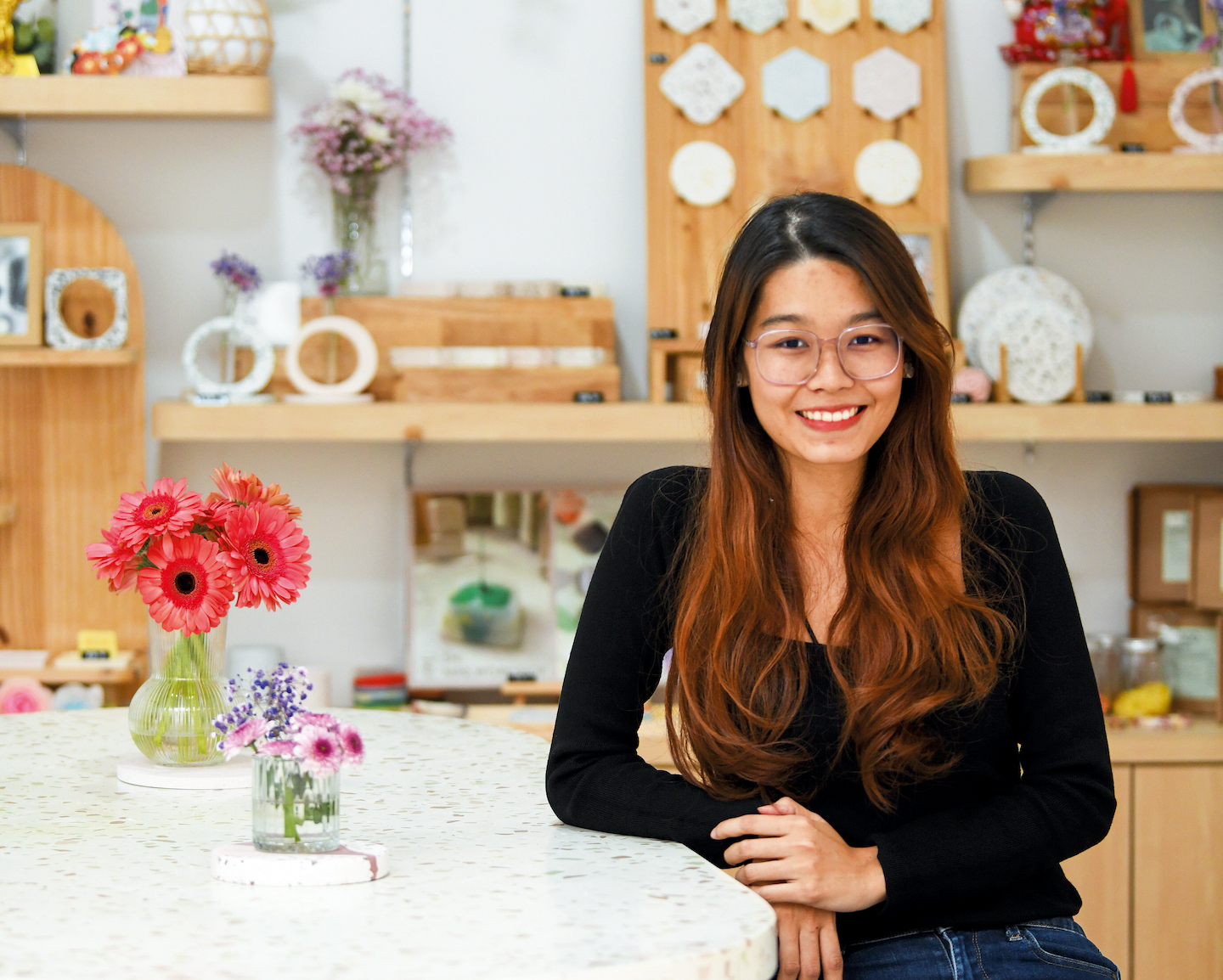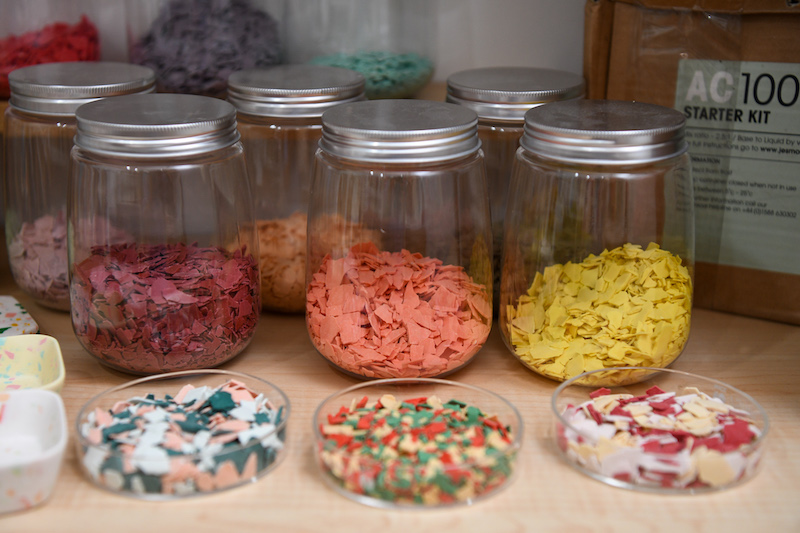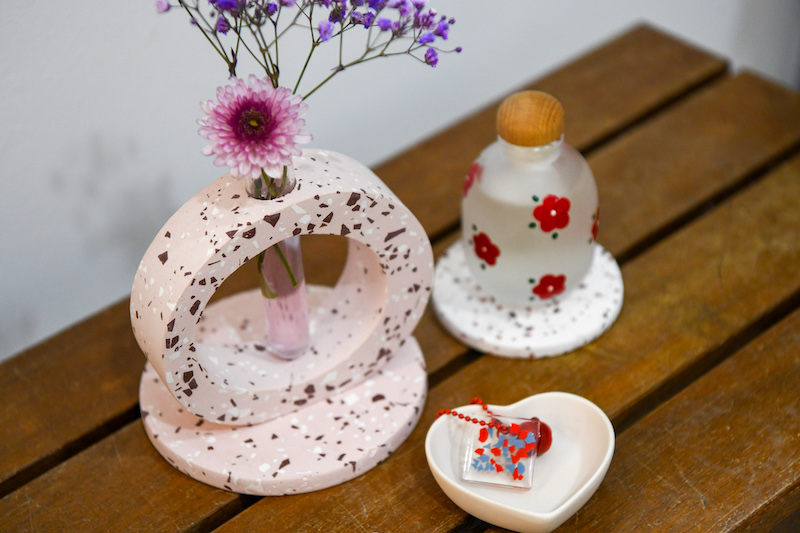
Founder and entrepreneur Tan Xin Lin (All photos: Low Yen Yeing/The Edge Malaysia)
When in search of historical tales, one thinks of digging underground. But if you look down to see your feet planted on terrazzo floors, you really only need to stay at ground level.
The earliest samples of terrazzo date back as far as 450 BCE. Excavations on ancient civilisations like Pompeii and Herculaneum have unearthed architectural artefacts featuring the recognisable chippings set in concrete bases.
In 1500s Italy, Venetian mosaic artists looking to make use of excess marble fragments built terrazzo terraces that they sanded by hand prior to the invention of the galera, a mop-like tool comprising a grinding stone attached to a long handle. Through the 17th to 19th centuries, terrazzo made its official debut in America and graced the abodes of the powerful and wealthy, with George Washington’s home in Mount Vernon, Virginia, and the Vanderbilt residence in New York City being some of the most noteworthy.
Terrazzo would continue to reach peak popularity from the 1920s and 1960s, becoming mainstays in the art deco and mid-century modern eras. However, demand in individual dwellings has lessened in recent years as homeowners gravitate towards wood, tile and carpet. Modern day terrazzo is mainly seen in public spaces (think shopping malls and hotel lobbies) where one’s attention does not linger long on the surrounding design. Some might even go so far as to say that terrazzo is dated and belongs in the past.
20231019_peo_shi_terrazzo_atelier_3_lyy.jpg

Regardless of its current traction, terrazzo remains near and dear to many who recognise it primarily from our grandparents homes or even childhood abodes. The never-ending colour and chip-size combinations are details beloved by maximalists everywhere, and if theories of trend cycles mean anything (they often do), it is likely that the coming years will see a gradual revival and reinterpretations of terrazzo. Need proof? Look no further than local small business Shí Terrazzo Atelier, founded by architect-turned-artist and entrepreneur Tan Xin Lin.
The now three-year-old business set up shop in GMBB, Kuala Lumpur, just three months ago. Shí is the romanisation of the Chinese character for “stone” and the third syllable in the word for terrazzo.
It all started with coasters. Tan recounts a period when she “wanted a coaster of [her] own” and after a fruitless search for one that satisfied her, she decided to look into DIY options. “I came across terrazzo coasters on Pinterest and thought, ‘This is quite pretty. Maybe I could make my own’,” she says.
Having just left her previous corporate job in the architecture realm, Tan had all she needed to get the ball rolling: time on her hands and a sense for design materials. “I was taking a break and not in a rush to find a new job, so this was something I started playing around with.” After the success of the initial coaster, she decided to make a small batch to sell. What surprised her was the warm response she quickly received from customers, swiftly followed by an invitation to participate as a vendor in a small business market. “I thought, ‘Why not? Let’s just give it a try’.” This marked the first of many pop-ups she, now a regular presence in the growing scene, would join.
20231019_peo_shi_terrazzo_atelier_18_lyy.jpg

Rather than flooring, Tan’s main focus is to “apply terrazzo designs to different things”. The label offers a variety of colourful trinkets that are the perfect pick-me-up. Shelves in-store are always stocked with trays, display plates, mini vases, keychains and more. One side of the shop is dedicated to collaborations Tan has done with other local artisans: a mini plate to set a diffuser on, stamps with cartoon prints, handmade bar soap with terrazzo patterns and candleholders resembling round beach pebbles.
As the sole operator behind Shí Terrazzo, Tan notes that she often lacks “enough time or hands to realise all [her] ideas” — from making the colour chips that are mixed into the concrete and resin bases she uses to sanding down each item to the perfect finish. Prioritising quality means the research and development phase of each product tends to be tedious, and starting over from scratch is something Tan is no stranger to. “Sometimes when I make a product for the first time, I end up not liking it,” she explains. “At the beginning, I was quite ambitious and planned to release new things every month but, in reality, I do not have the resources and time to do it so quickly.”
That said, the past three years have brought along much joy and eye-opening experiences. “There was a customer who came to buy a Christmas gift for a friend,” she recalls. “When I asked what kind of product he was looking for, he said anything would do so long as it was from my store because Shí was on the receiver’s wishlist. It really warmed my heart.”
20231019_peo_shi_terrazzo_atelier_11_lyy.jpg

Most touching, though, is the way running the business has imparted a sense of fulfilment in Tan’s life and aided her through difficult times. “[Terrazzo] is like art therapy for me. It calms me and it is very labour-intensive, but I enjoy it. It has helped a lot in times of anxiety,” she mentions.
What goes around comes around, and Tan is keen on spreading this peace to others, not just through her pieces but at her occasional workshops where she enlightens others on the beauty of terrazzo and the joys of art. “I enjoy teaching in workshops because I get to see how other people mix the colours and be happy with something they made,” she notes.
Despite the brand’s relatively young status, Tan’s originality makes for creations that stand out in a large sea of self-made businesses. Dishes and charms are only the beginning, as she plans to bring her skills to the furniture industry in the near future. An oblong table with an eggshell beige terrazzo surface, the very first prototype she made, is a testament to her design savviness and a precursor for exciting things to come, one of those being an era of colour and love for quirky and irregular, yet sentimental aesthetics.
To browse Shí Terrazzo Atelier’s products, visit @shi.atelier on Instagram or swing by the physical store at Level 8-36, GMBB, 2 Jalan Robertson, Bukit Bintang, KL.
This article first appeared on Nov 13, 2023 in The Edge Malaysia.


